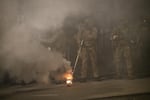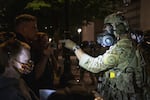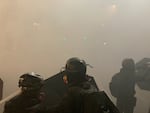On Wednesday, a pro-Trump mob storming the U.S. Capitol seemed to face little resistance from law enforcement, breaking into the heart of the federal government with shocking ease.
Local Black Lives Matter protesters, glued to the insurrection at the Capitol at home and at work, said they were struck by the restraint with which law enforcement responded to the mob of mostly white Trump supporters in Washington D.C. compared with the tear gas, riot munitions, and other heavy-handed tactics police — including federal law enforcement — used on them in Portland this summer.

Federal law enforcement officers fire impact munitions and tear gas at protesters demonstrating against racism and police violence in front of the Mark O. Hatfield federal courthouse in Portland, Ore., on July 16, 2020.
Jonathan Levinson / OPB
“Every night we were met by violence. Tear gas, batons, arrests, right away. And that would just be for us out there yelling and vocalizing our frustrations of us being killed,” said Dre Miller, an activist and regular attendee of the nightly racial justice demonstrations that began with the police killing of George Floyd in Minneapolis last summer and stretched into early fall. “But today it wasn’t like that. It was vacant. It was available for them to actually overthrow the capitol.
“It’s just wild how different the response is.”
Miller was hospitalized in July after federal officers shot him in the head with a tear-gas canister. He said Wednesday’s events served as just the latest example of far-right groups receiving what he and other activists perceived as favorable treatment at the hands of law enforcement.
In Portland over the summer, police stood by and watched as far-right activists brandished guns and clashed with counter-protesters. In Salem last month, far-right protesters successfully broke into the Capitol as legislators met inside. And now, a swarm of Pro-Trump insurrectionists had breached the U.S. Capitol without the mass arrests or rubber bullets that had become commonplace at Portland’s protests.
“If we even got near buildings, we would get dispersed. We were met with violence,” Miller said. “If this was our event and rally today in Washington D.C. and we did the same actions ... we would be shot right away.”

Protesters demonstrate against racism and police violence in front of the Mark O. Hatfield federal courthouse. Earlier in the night, federal law enforcement officers shot a demonstrator in the head with a less-lethal impact munition, causing severe injury.
Jonathan Levinson / OPB
Gregory McKelvey, a political consultant who led Portland’s Black Lives Matter protests in 2016, said he too felt certain real bullets would have been fired had Black Lives Matter activists attempted to take over the Capitol rather than a largely white crowd of Trump supporters.
“People in Portland were gassed and beaten for far less than what these people did — for simply just being in a park that was close to a federal building,” McKelvey said. “These people are invading a federal building that is occupied by elected officials doing the government’s business and have seen none of these tools that were used against Portland protesters.”
As of Wednesday evening, at least 13 arrests had been made related to the insurrection at the Capitol. On Portland’s 100th night of consecutive protests on Sep. 5, police arrested 59. That night, police said “multiple firebombs” had been launched at officers, who responded to the gathering with a riot declaration, impact munitions and tear gas.
“What we witnessed in D.C. was probably the most restraint to a situation that they probably shouldn’t have been as restrained to that I have ever seen in my entire life,” said Zakir Khan, board chair of Oregon’s Council on American-Islamic Relations, pointing to footage of law enforcement gently guiding members of the mob away from the Capitol steps.

A neighborhood enveloped in thick smoke from tear gas canisters disturbed local residents during the 121st night of protests for racial justice in Portland on Tuesday, Oct. 6, 2020.
Sergio Olmos
“They could have done all of this stuff during the height of all of the protests that took place in Portland and chose not to.”
Khan said he believed this arbitrary nature of when police crackdown and when they step aside “undermines the entire profession.”
“What we have witnessed today not only is a failure of policing,” he said, “but it’s a failure to just uphold certain standards of professionalism within the field.”



